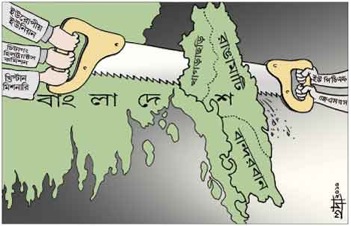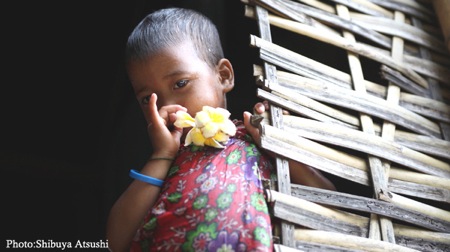By Rahnuma Ahmed
A cartoon had caught my eye. Published in a Bengali national daily, soon after the recurring incidents of ethnic violence in Rangamati and Khagracchari in February this year, it shows a map of the south-eastern part of the country. The land mass is coloured a sea-green. The letters forming the word `Bangladesh’ are printed in black. An irridescent grey shades off into black in parts, it presumably represents, but indistinguishably so, both Indian territory and the Bay of Bengal’s waters.
It shows the Chittagong Hill Tracts?with the districts of Khagracchori, Rangamati and Bandarban clearly marked out?being sawn off by arms clutching wooden handles, fixed to both ends of the saw. To the right side of the cartoon, extending into Bangladesh as it were, are two arms, while on the left, three. The arms on the left side of the map are clothed. The first two hands reach out of their coat-covered shirt-sleeves. Clothed. Civil. The last one juts out of what seems to be a clerical coat-sleeve. The topmost coat-sleeve has `European Union’ written on it. The second, `Chittagong Hill Tracts Commission.’ And the third, `Christian missionary.’ Both arms to the right are bare. Uncovered. One has `UPDF’ (United Peoples Democratic Front) scrawled on it, while the other, `JSS’ (presumably referring to the PCJSS,? Parbatya Chattagram Jana Sanghati Samiti). No clothes. Barbaric.

A nation beseiged by enemies within and without. The cartoon thereby evokes a sense of crisis. Fear. Anxiety.
It is, I thought to myself, a perfect example of all that which bedevils the nation nearly forty years after independence. There are many signifiers. There are both presences, and absences. Those present?and named?are the enemies. These foes are both internal, and external, to the nation. They are out to destroy the nation. To sever its limb. Only those present (in the cartoon) wield power, and malevolently so.
The Bengalis are absent. It is this absence which captures very well, I think, how Bengalis increasingly prefer to portray themselves when confronted with their power as ethnically dominant, and overwhelmingly so, within this nation. The act of absencing makes Bengalis appear powerless. As a victim, one who is defined in the dictionary as,
a helpless person somebody who experiences misfortune and feels helpless to remedy it
[victimhood] fall victim to somebody or something, to be affected, harmed, or deceived by somebody or something
Bengalis are the victims of regional and international machinations. Of forces who are infinitely more powerful. Forces external to the nation, with whom bad elements within the nation, the `tribals,’ have ganged up.
I cannot help but think, how would the cartoonist have portrayed 1971? East Pakistan, being cut asunder by, who? Aided by, who? But of course, let me add, when I compare the situation in the CHT at present to the situation confronting Pakistan in 1971, I do not do so, from any ulterior motive of advocating a break-up, or secession, or any such thing. I do it because ekattur has taught me that to survive as a nation, one must not only be able to accommodate cultural differences, but to welcome them. That what the centres of power label a `conspiracy’ is most likely, a political problem, one that must be resolved politically, never, ever, through the deployment of brute force. That genuine attempts must be made to undo historical wrongs. Before it is too late.
That lives matter. That homes matter. That justice matters.
I muse to myself, why are there no Bengalis in the cartoon? Probably because however hard one tries to depict them innocently, the very labels, `government,’ `army,’ `police,’ `settlers,’ are heavily-laden with power. With Bengali power, and historically so. The nation’s history is built on ethnic domination, it is one that continues in the historical present. I muse to myself, the cartoonist must have realised that putting in Bengalis just wouldn’t do. The victim myth would have become unsustainable. That it would be better leave them out. Altogether.
But the absence has been made present through other means. Very distinctively so. The letters printed on the land mass. Bangladesh. Bangla+desh, the land of the Bengalis. A literal rendering. It homogenises differences among Bengalis, differences to do with class, gender, religion, regional, linguistic (many Sylhetis think of themselves as Sylhetis and not Bengalis), historical. And among indigenous peoples too, Chakma, Marma, Tripura, Santal, Bawm, Tanchangya, Rakhain, Garo, Lushai, and many others. The construction of a Bengali sameness becomes an ethnic norm, one to which others must aspire. Must wish to belong.
Soon after independence, we had been too heady to grasp the wisdom that lay behind Manabendra Narayan Larma’s words, ?Under no definition or logic can a Chakma be a Bengali or a Bengali be a Chakma? As citizens of Bangladesh we are all Bangladeshis, but we also have a separate ethnic identity, which unfortunately the Awami League leaders [the then-ruling party] do not want to understand.” The change that Ziaur Rahman had effected after coming to power had to do with nationality, with national belonging?`Bangladeshis’ instead of `Bengalis,’ the latter had been held to be universally applicable for all citizens regardless of their ethnic belonging. It was a technical correction, having been accompanied by the military occupation of the Chittagong Hill Tracts. By death and destruction. By rape. By the settlement of landless Bengalis on pahari land. It led to the flight of indigenous peoples in large numbers, to neighboring India where they sought refuge.
In order to portray `the’ Bengali as victim, the cartoonist must suppress the Bengali presence. That, surely is interesting?

Bengali writers however, are more forthcoming. Some claim, Bengalis are indigenous, have been so for centuries, or better still, since time immemorial. It is the paharis, who are settlers. The `tribal’ rulers are exploiters. Hilly people are extremists. They did not take up arms to resist Bengali oppression, to regain cultural autonomy, but because they are.. have always been.. for many centuries.. bandits and criminals. They abduct and kidnap Bengalis. Others write, some foreign NGOs have ulterior motives. They want the army to withdraw before amicable relations have been restored between paharis and Bengalis. Foreign forces, such as the European Union, some foreign members of the CHT Commission, have become active under cover of the Peace Treaty (1997). There are plans afoot to sever the CHT from Bangladesh, to re-make it on the lines of a Christian East Timor. Bengali settlers are being slaughtered. Their houses are being razed to the ground. Even military personnel are being attacked. Muslims are being prevented from entering their mosques. From praying. A large conspiracy is in the offing.
Can such paranoid ramblings, whether depicted visually through cartoons or written out in articles, counter imperial politics? Concerns over national sovereignty are real, are justified in these times when US-led imperial terror, one in which western European nations are fully complicit, has been unleashed worldwide. To save the nation, a genuine leap of imagination is needed. One which does not confuse the roles of `perpretator’ and `victim.’
Published in New Age April 5, 2010
